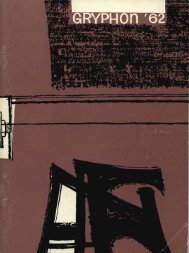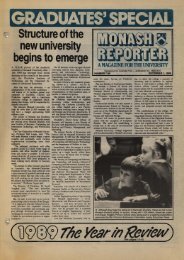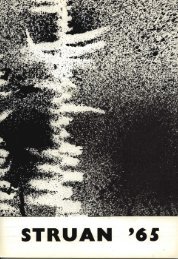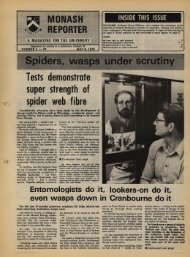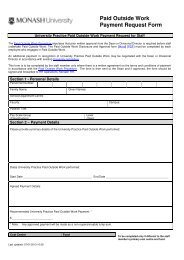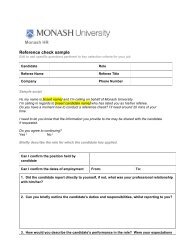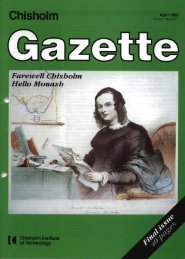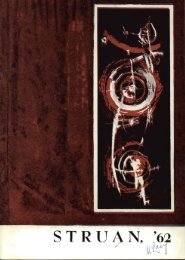GAZETTE - Adm.monash.edu.au - Monash University
GAZETTE - Adm.monash.edu.au - Monash University
GAZETTE - Adm.monash.edu.au - Monash University
- No tags were found...
Create successful ePaper yourself
Turn your PDF publications into a flip-book with our unique Google optimized e-Paper software.
MONASH UNIVERSITY <strong>GAZETTE</strong>place for the tourist - apart from the historical interestof many of the buildings, it is one of the great treasurehousesof art of the world.It would be impossible to describe all the places thatone should visit there, but some are particularly noteworthy.First and foremost is the Hermitage, the winterpalace of the czars, a baroque style building erected byRastrelli in 1754-62 and the largest and most splendid inLeningrad. The outside is intricately ornamented withwhite pillars, cornices and mouldings contrasting withthe green colour of the walls. In addition there arecupids' heads, lions' faces and scrolls over the walls,and the roof edge bears 176 statues interspersed withornate vases. Inside there are over a thousand rooms andhalls with a total floor area of 495,000 square feet; forthe statistically minded, there are also 1,945 windows,1,786 doors and 117 staircases. Now consider that thisspace is packed with art works from all over the world,largely collected by a succession of czars, and alsocontains a museum of archaeological and historicalmaterials, and you will appreciate the magnitude of thetask in "visiting the Hermitage". Despite several visits,I did not see all of it!Nearby, on the same side of the river, are many otherhistorical places. The Smolny Institute, originally aschool for young ladies of noble birth, was taken overby the early revolutionary government in 1917 and wasthe home of the Soviets until the government moved toMoscow in 1918. It is now a museum of the revolution.There is also the Museum of Russian Art which containsa be<strong>au</strong>tiful collection of old icons, as well as worksrepresenting nearly all the major Russian artists.Across the river from the Hermitage is the magnificentand impressive Peter and P<strong>au</strong>l Fortress. This isreally the foundation stone of the city, for here in 1703,on an island commanding the navigable stream of theriver, Peter the Great commenced the construction of afort to hold the lands he had conquered. Within thewalls were barracks and, later, cells for political prisoners,the lists of whom read like a Who's Who ofRussian revolutionary history from 1790 to 1917. Alsowithin the walls were the Mint and the be<strong>au</strong>tiful Peterand P<strong>au</strong>l Cathedral which contains the sarcophagi of allthe czars of Russia except two. The cathedral spire,clad in gold leaf, is the highest structure in Leningrad- 400 feet with the exception of a new 1,000 foottelevision tower.There are many more places worth visiting in thecity. Interestingly, there are no tall buildings in Leningrad.To emphasize the lowly stature of his subjectsNicholas I decreed that all building in SI. Petersburgmust be seven feet lower than the Winter Palace; onlychurches might be higher, a realistic appraisal of thehierarchy. Outside the city are the Summer Palace atPetrodvorets with its incredible fountains (frozen solidat the time] visited). the Ekaterininsky Palace at Pushkin(formerly Tzarskoye Selo ), the country residence ofCzar P<strong>au</strong>l at Pavlovsk, and to the north the home ofthe artist Repin. All are within a few hours' drive of thecity.But all good things must end. The cold weather andmy long-lost suitcases arrived at the same time, and]settled down to giving my lectures. This involved asession of several hours with my interpreter, going overthe material for the day's lecture, followed by a twohour lecture with a five-minute break in the middle. Inaddition I gave a number of "slide shows" to variousgroups about <strong>Monash</strong> and about Australia and two filmshows to capacity <strong>au</strong>diences. I also organized a bookdisplay with the materials I had brought with me. coveringAustralian geography, literature, painting, architecture,flora and f<strong>au</strong>na, which was very well receivedand attracted many visitors.During my visit I was taken to several scientific institutionsaround the city where I met and talked withmany fellow biologists. I was impressed with theirfriendliness and the open way in which they discussedtheir work and problems. I was very disappointed withthe standard of scientific equipment; this seemed to bein short supply and of not very advanced design, thoughobviously I only saw a limited array. Many types ofequipment that may be purchased "off the shelf" in theWest have to be specially made up, and many moderndevelopments in equipment technology have not beenheard of by workers there. I have no doubts about thequality of the research being conducted in the <strong>University</strong>.but there was not the diversity that] was accustomedto seeing in universities in Australia and theUnited States, and investigation was restricted to a fewmajor themes.Training of students has recently been dealt with byM. A. Jaspan in Vestes, IX, 249-252. I was impressedwith the depth of the undergraduate courses and theexcellent text books supporting all courses; on the otherhand, neither visual aids nor printed notes are used inteaching. The first degree takes five years and graduatetraining is also more protracted than in Western universities.[ am sure that this time could be r<strong>edu</strong>cedsubstantially with improved methods of teaching andexamination, both of which rest too heavily on the oldEuropean tradition.I count this visit as one of the great <strong>edu</strong>cational experiencesof a lifetime, and I unreservedly supportcontinuation of the scheme. I found that Australia isnot well known in the Soviet Union and, in fact, isregarded as a somewhat exotic place of natives andkangaroo farms, but many of our own misunderstandingsof the Soviet Union, the largest country in the world,are just as bizarre. Exchanges in both directions can donothing but good.------FIRST DOCTOR OF MEDICINEDr. F. H. Hocking, who has been working in the departmentof Medicine at the <strong>Monash</strong> Medical Centre, PrinceHenry's Hospital, has been awarded the degree of Doctorof Medicine.He has written a thesis, "Human Reactions to ExtremeEnvironmental Stress". His work began after interviewsin Australia with people who had been victims of theNazi concentration camps. From his studies he concludedthat everyone has a breaking point, although forsome this may come many years after the exposure tostress.Dr. Hocking will receive his degree at a conferringceremony in December. At the same ceremony Dr.Ch'ng-Tan K. Siew will receive her Doctorate of Philosophy.She is the first Asian woman to gain a Ph.D.from <strong>Monash</strong>. Her thesis concerned freshwater musselsfound around Echuca.18




